Despite their squad possessing the second-lowest transfer market value in Ligue 1, trailing only Ajaccio who sit second-from-bottom and look destined for relegation at the time of writing, Clermont Foot have enjoyed a solid campaign, with manager Pascal Gastien on course to not just steer his side to safety yet again, but perhaps even secure a top half finish, marking a major leap from last season’s close shave to finish up in 17th place in what was the club’s first-ever top-flight campaign.
All this comes off the back of a summer transfer window in which many of Les Lanciers’ key players from last term departed the club. Mohamed Bayo was the most high-profile departure, with the Guinea international joining Lille for €14m. Salis Abdul Samed (€5m to Lens), Cédric Hountondji (€2m to Angers), Jason Berthomier (free to Valenciennes), Vital Nsimba (free to Bordeaux) and Akim Zedadka (free to Lille) are among the others to have left Stade Gabriel Montpied last summer. All were key first-team players last season.
Clermont recouped a total of €21.4m on summer transfer fees and spent just €2.3m on replacements, according to Transfermarkt. However, with five games left to be played in the 2022/23 campaign, Gastien’s men have comfortably eclipsed last season’s points tally of 36 from 38 games by accumulating 49 points in 33 games…and counting.
The team have overperformed both in terms of exceeding what was believed to be their ceiling and in terms of maximising the results from the quality of performances they’ve delivered. But what exactly has been going on at Clermont Foot and how have they pulled off such an achievement, sustaining this overperformance over the course of the season?
This tactical analysis and team-focused scout report will look at five significant areas explaining Clermont’s positive 2022/23 campaign. We’ll provide some analysis of relevant aspects of the team’s strategy and tactics in and out of possession, as well as look at how the team evolved from last season to this one.
Squad evolution
This section is titled: ‘Squad evolution’ but to an extent, we were very tempted to name it ‘Squad transformation’ — the reason being that so many of their key players departed and were replaced that the names on the team sheet have changed entirely, as has the team’s shape.
However, when observing the tactical approach on the pitch and the roles of some key players, we can make the bridge to last season and better understand how they got from A to B.
Among Clermont’s most-used players this season are Jim Allevinah, Alidu Seidu, Yohann Magnin, Johan Gastien, Saîf-Eddine Khaoui and Elbasan Rashani.
All six men were at Stade Gabriel Montpied last season and comprise Clermont’s most-used starting lineup this season, with Khaoui just about getting more minutes than Muhammed Cham Saračević, who’s been a star man for his club at right attacking midfield this term despite not playing enough to make the theoretical most-used starting eleven.
While all of these players were at the club last season, most wouldn’t have made their most-used starting lineup last term. In fact, only Johan Gastien — not just a namesake but the 35-year-old son of Clermont manager, Pascal — and Rashani would make the most-used starting eleven for both seasons.
Other than them, all players previously mentioned made a big step up in 2022/23, becoming first-team starters after having previously been squad players.
We mentioned a change in shape at the beginning of this section. While Clermont mainly lined up in a 4-2-3-1 shape last season, they’ve primarily been in a 3-4-2-1 this term.
However, while these two shapes share few similarities at first glance, the differences have all been out of possession. In possession, Clermont look very similar from last season to this season.
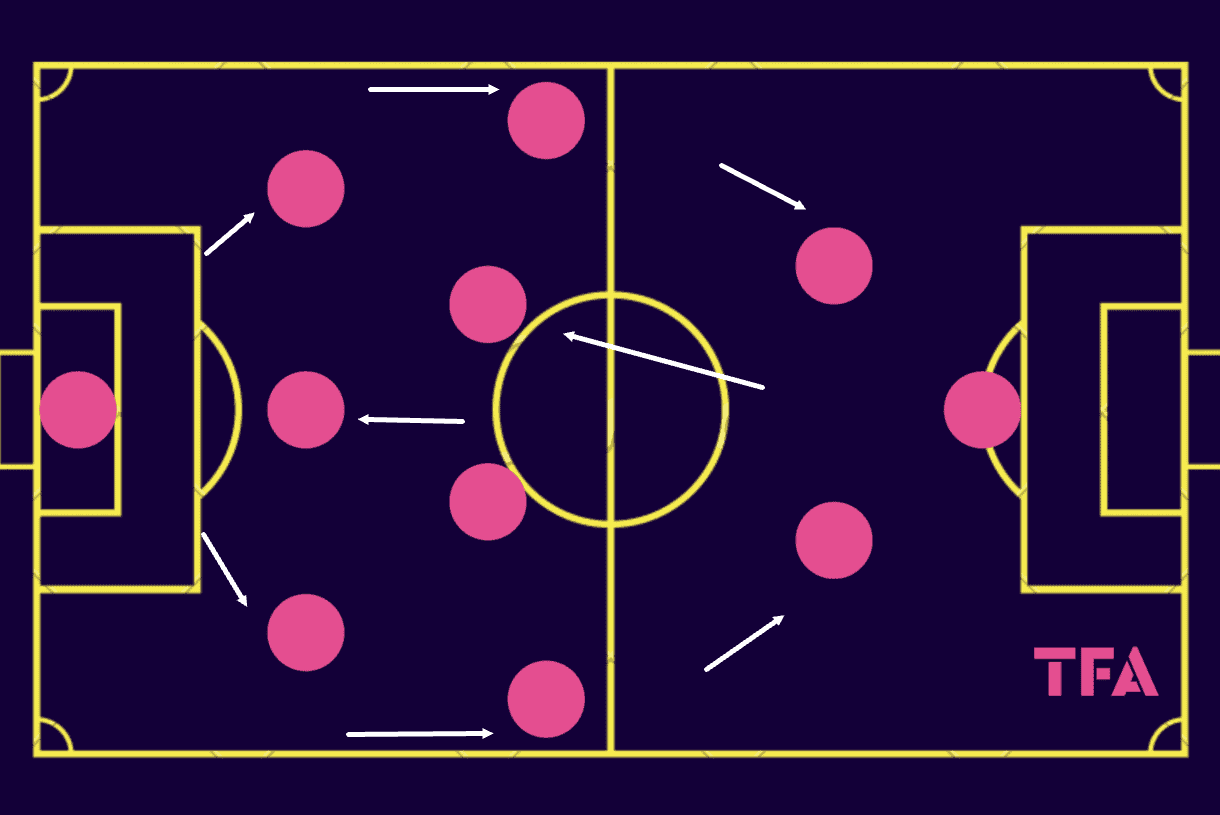
This is because last season, directly from the build-up, one of their holding midfield duo would typically drop deep into the backline while the centre-backs split wide, the full-backs advanced, the wingers tucked in and the ‘10’ dropped deeper to fill the vacant spot in midfield created by the holding midfielder’s initial movement. This created something of a 3-4-2-1 shape, as visualised in figure 1.
This season, directly from the build-up, Clermont form the same shape but it’s an even more natural transition from their defensive shape.
Johan Gastien’s role
The manager’s son, Johan Gastien, and his role in the team’s tactics is arguably the biggest constant of all over the two seasons. Gastien was the player who primarily dropped deep from holding midfield into the backline last season, and we’re still seeing him drop from his advanced position into deeper positions quite a bit this term, despite three centre-backs now sitting behind him instead of just two.
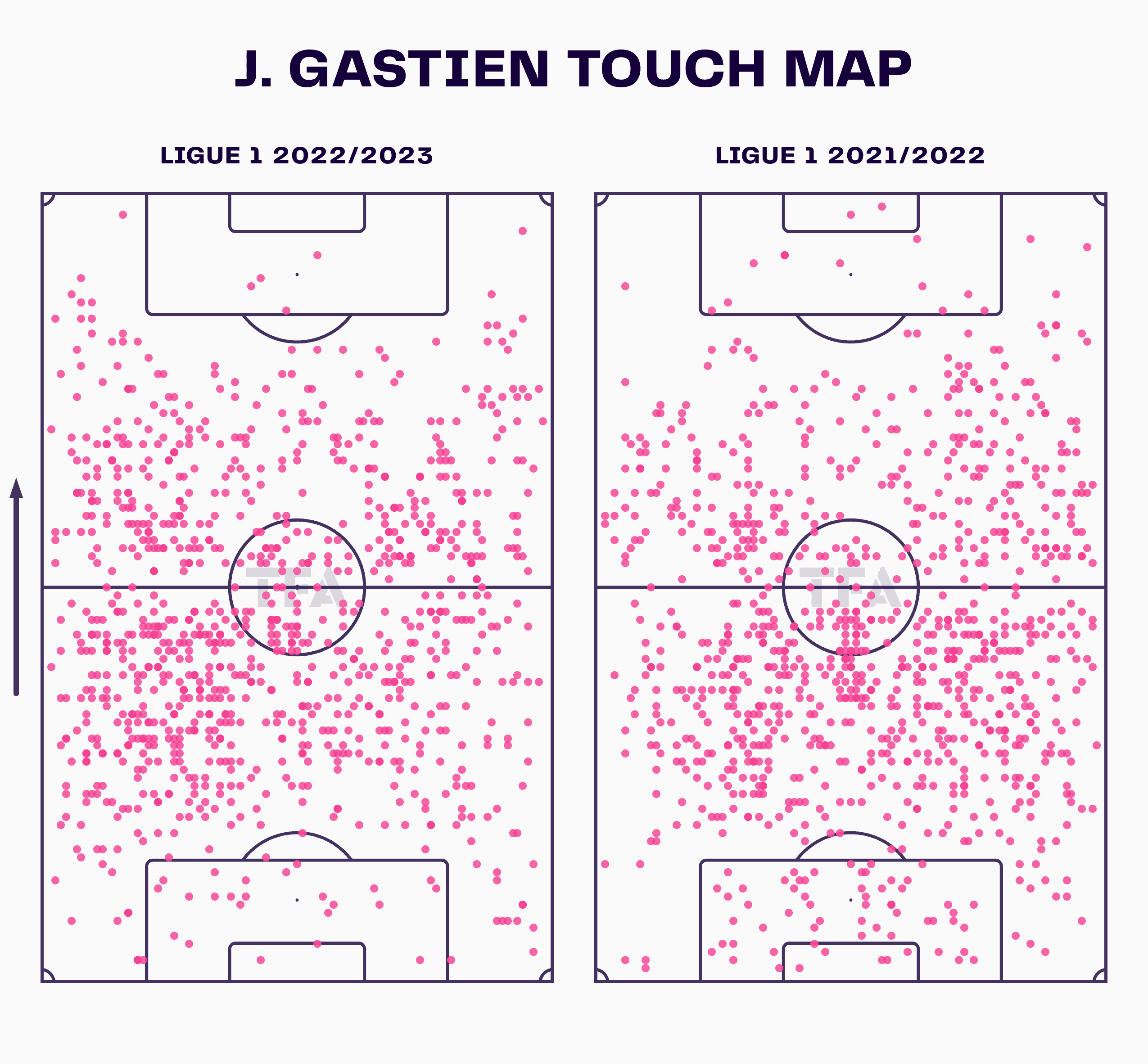
In figure 2, we have the midfielder’s touch map in 2022/23 compared with 2021/22 that he’s got on the ball all over the pitch at times but especially in deeper areas, though it tended to occur more in central positions last season whereas he’s veered more to the left this term.
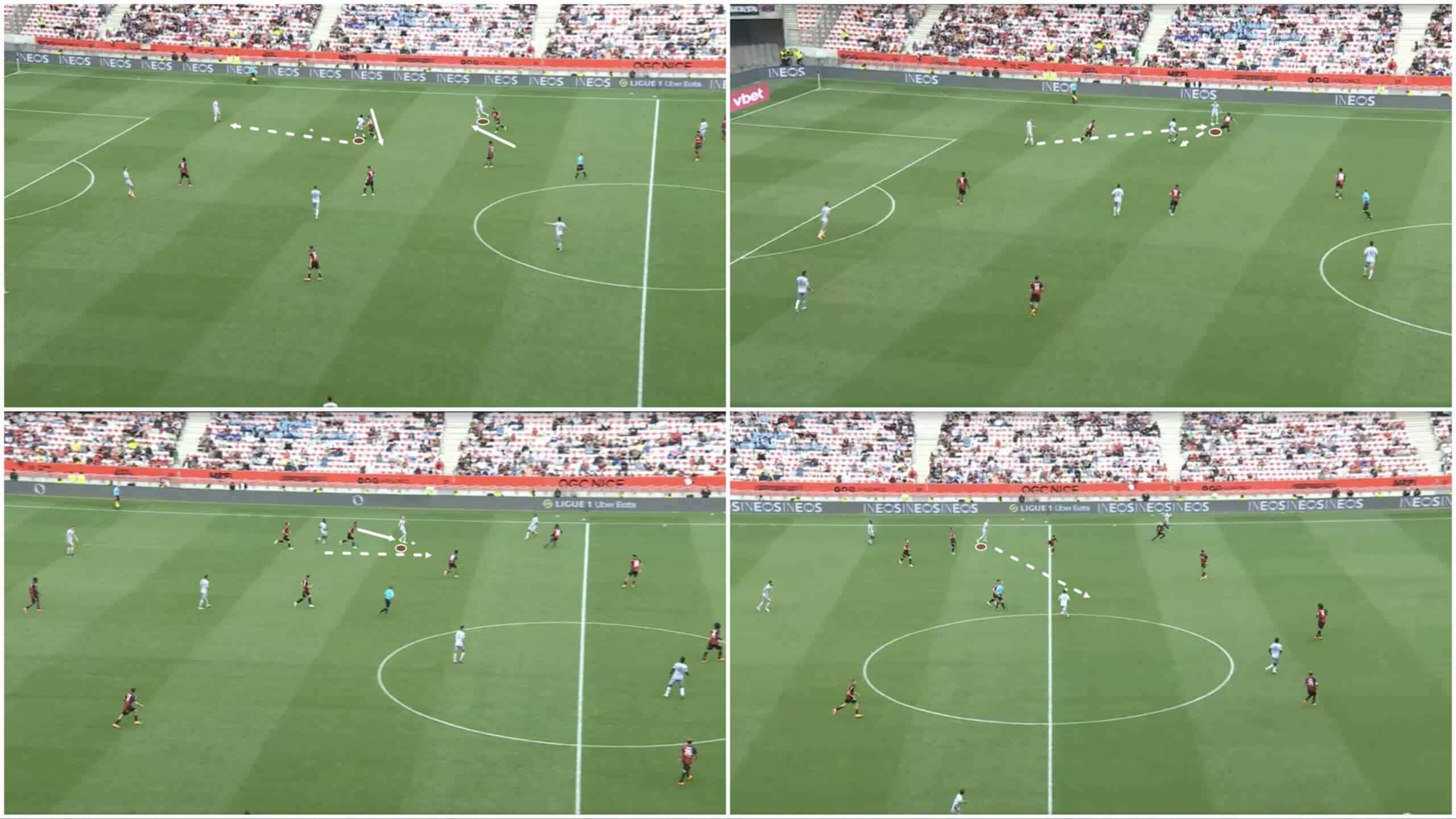
We see an example of this in figure 3, with left wing-back Neto Borges having just carried the ball inside, creating space for Gastien to drop out wide and fill in his position. This is a rotation that Clermont will make quite frequently in the build-up phase as they look to free up Gastien and find an opportunity to get him on the ball to help the team progress upfield. The 35-year-old’s passing quality and range of vision make him an excellent asset in the build-up and ball progression.
Here, after receiving out wide from the left centre-back, Gastien performs a one-two with Borges before playing a pass into the ‘10’ from the left, helping his team break through the opposition’s midfield line and set up an opportunity to run at the defence.
Gastien will always look for space to drop into as he likes to receive away from the opposition markers and have a little bit more time to turn, face forward and get his head up to pick out his progressive pass. Of course, he’s receiving with his back to goal and having to quickly turn under pressure more this season than last because of the fact three centre-backs are behind him, so he doesn’t drop quite as much; this is a role he’s well capable of playing.
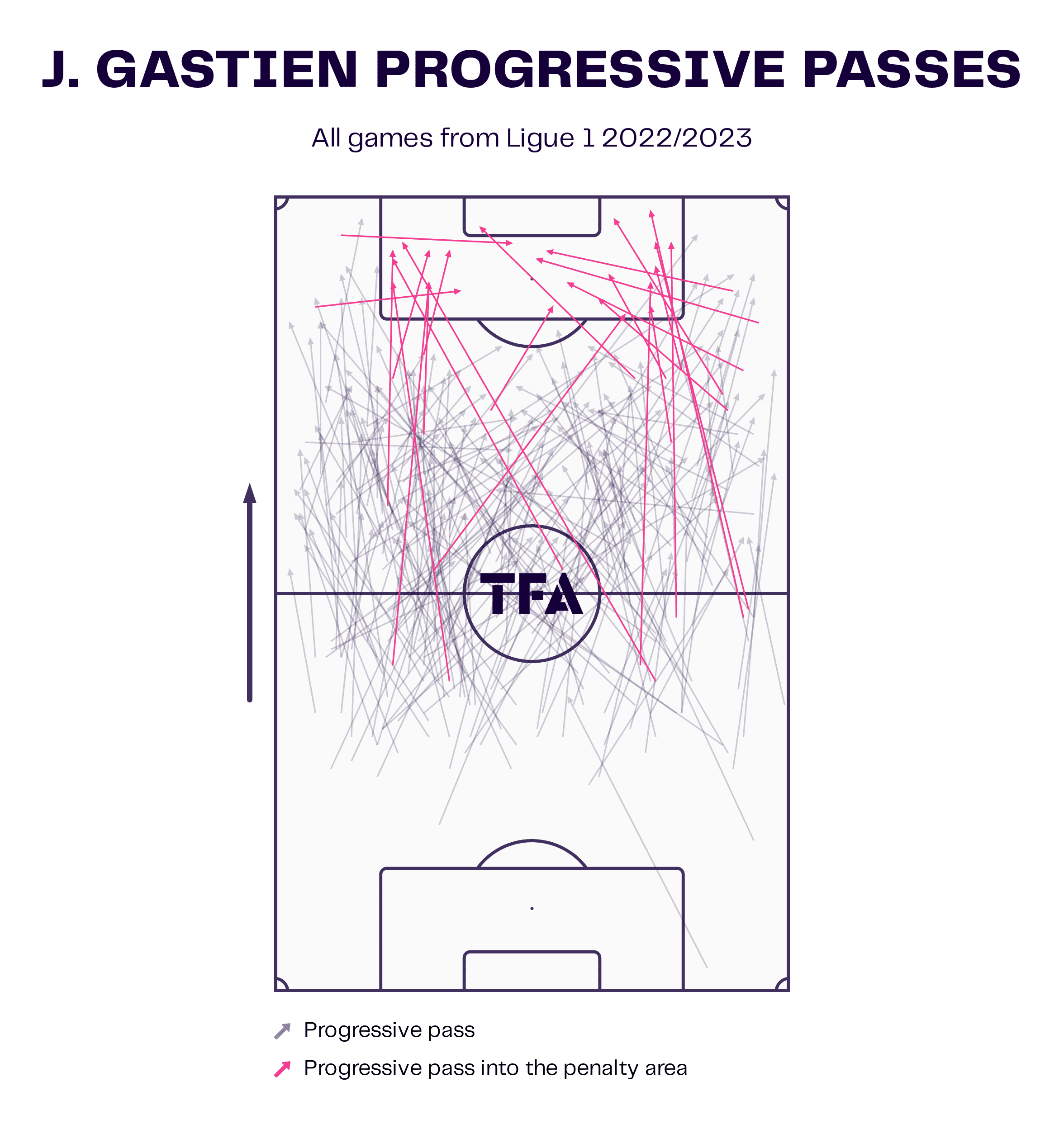
However, he loves dropping to get a bit more space and really being able to exercise his range of passing to help the team get forward and it’s common to see him acting as a bit of a quarterback, as his progressive pass map in figure 4 displays.
Clermont have made more dribbles this season (25.54 per 90) than they did last season (22.86 per 90). Dribbles are an important part of their offensive approach as the wide defenders and wingers have been required to take on the opponents a lot over the last two seasons, with Clermont winning the most fouls over the last two Ligue 1 campaigns largely as a result of their dribbling tendencies and the encouragement their wide players get to drive at the opponent with the ball.
Chance creation
This has increased this season with a lot of that down to the fact Khaoui and/or Cham have replaced Berthomier in the starting eleven, and both complete, on average more than one dribble per game more than Berthomier did, with Berthomier often dropping into central midfield in possession and being more of a passer than a dribbler, like Cham and Khaoui are. Cham, especially, is a frequent dribbler who’s been a top target for his deeper teammates to look for in ball progression this term.
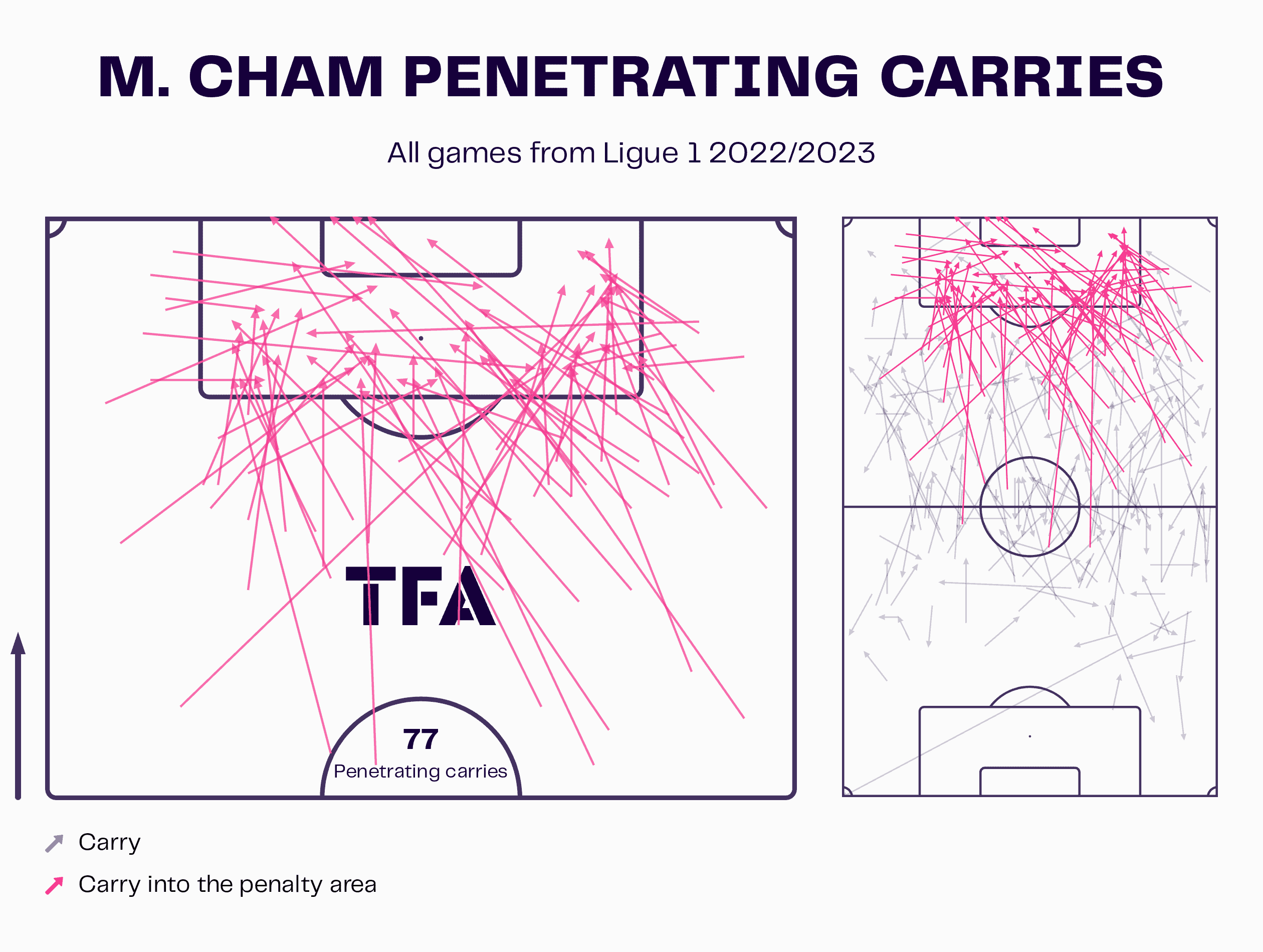
A key part of Cham’s role in the squad is to find some room in the right half-space to give his deeper teammates a good option, turn on the ball and carry forward. His penetrating carries map from 2022/23 highlights his dribbling tendencies and how he’s helped progress his team into dangerous positions via his ball-carrying.
We discussed Cham in detail in a player analysis article back in our December edition of the Total Football Analysis magazine, so won’t go into too much detail here but in short, he’s an excellent line-breaking dribbler who operates well under the freedom given to him by Gastien. He works well in tight spaces and is good at riding challenges to progress his team through the opposition’s defence. Again, for more specific details on how he achieves this as well as more about the player’s game, feel free to check out the article in our December magazine.
Cham hasn’t just been an asset in ball-carrying and chance creation, the 22-year-old who was signed by Clermont back in 2020 from FC Admira Wacker Mödling of his native Austria but only made his first-team debut for Les Lanciers this term after having been sent out on two different season-long loan spells since initially joining Clermont has also played a key role in replacing the goals of Mohamed Bayo after the star striker left for Lille last summer.
Bayo finished as Clermont’s top goalscorer with 14 in Ligue 1 last season. This was six more than Rashani with eight, who finished as the second-highest goalscorer ahead of Jodel Dossou and Lucas Da Cunha with three and two, respectively. Nine more players scored one goal each last term. Overall, Clermont ended the 2021/22 Ligue 1 campaign with 38 goals — the fourth-lowest total in France’s top flight.
This season, Cham is tied at the top as Clermont’s top scorer with Grejohn Kyei, who was a January signing from Swiss side Servette last year, on seven goals each. Khaoui comes next with five, ahead of Komnen Andrić — a €1m summer signing from Dinamo Zagreb — on four. Rashani and Gastien both have three goals, left wing-back Borges, who joined last summer from Belgian Pro League side KRC Genk, has two.
Finally, right wing-back Allevinah, who primarily played as a backup winger last season, has scored once, as has Dossou, Jérémie Bela who joined from EFL Championship side Birmingham City last summer and Maxime Gonalons who also joined Clermont last summer from LaLiga 2 side Granada.
So, just two fewer players have scored, in total, for Clermont this season than last but the goals have been far more evenly distributed than last term, with seven players scoring more than once as opposed to just four last season.
Les Lanciers haven’t topped last season’s total of 38 goals yet but they’re on course to do so, with 36 to their name at the time of writing.
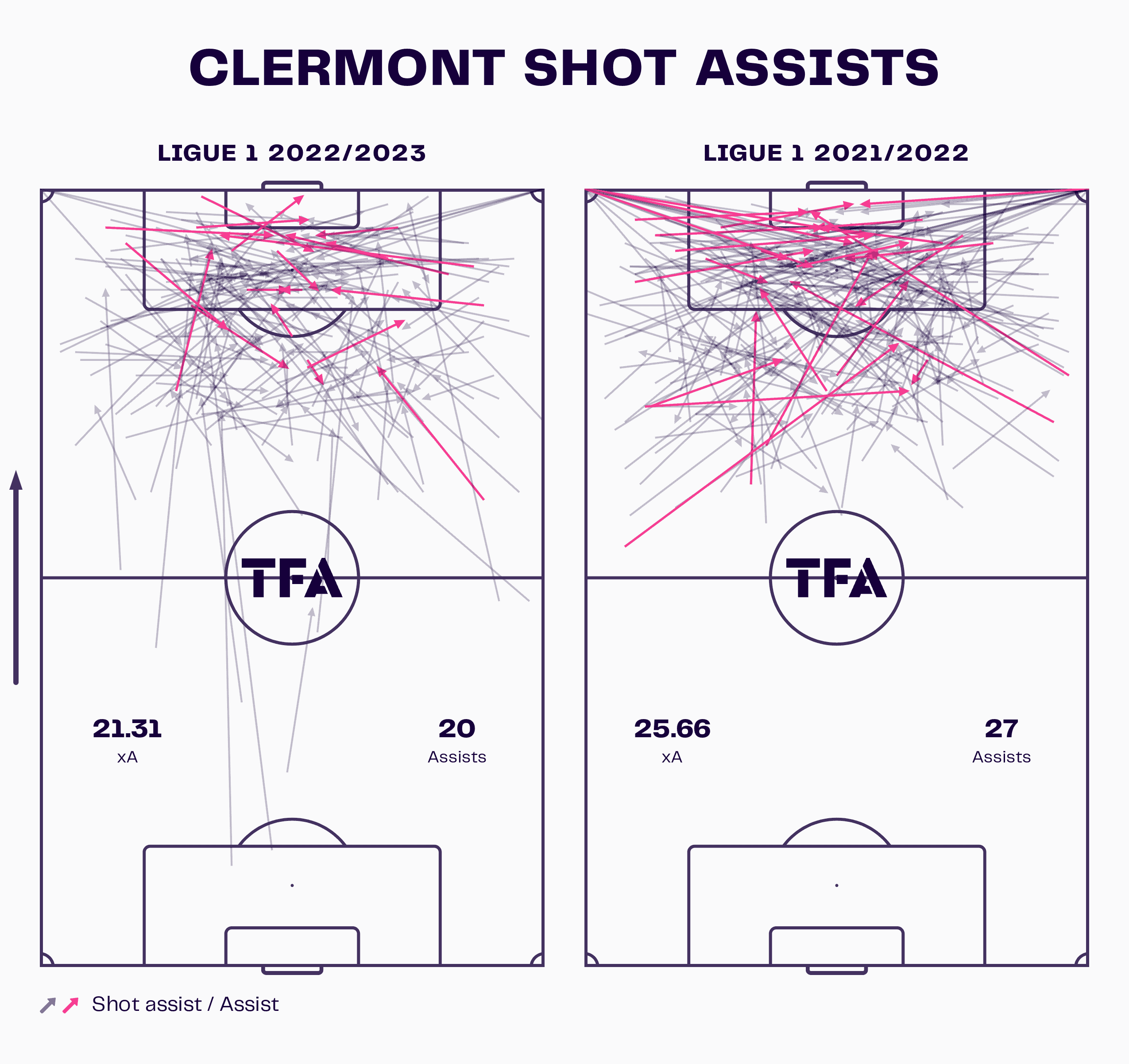
In terms of chance creation, the shot assist maps above comparing 2021/22 with 2022/23 tell a pretty accurate story. In general, Clermont’s shot assists have come from fairly similar areas — through balls or crosses from the half-spaces or low cutback crosses from the edge of the box out wide. However, Clermont have made fewer crosses this season (11.43 per 90, the fourth-fewest in the league, compared with 14.32 per 90 last season, the sixth-most in the league).
Zedadka (3.33 per 90), Nsimba (3.28 per 90) and Dossou (3.18 per 90) were first-team players who all loved to cross frequently last season, and they had Bayo in the centre of the penalty area to aim for on top of that. It made sense for Clermont to cross more last term. This season, each of the above three players has left the club, as has striker Bayo.
Naturally, the attacking approach has changed with that, to suit the players’ needs and preferences.
Of course, Clermont still cross, but less than before. Borges has made the most crosses in total (80) and this equals 2.82 per 90. Allevinah on the opposite wing has made 2.69 per 90 while Rashani has made 2.61 per 90. However, it’s obvious that these players take a different approach in chance creation than those who played the most minutes for Clermont last season.
The main features of the way in which Clermont move the ball up the pitch and create chances are: 1. Gastien will find space and get on the ball in some deep position before launching it forward for his wingers/attacking midfielders or wing-backs to receive; 2. The receiver will run at the opposition’s backline and attempt to beat one or two players while progressing towards the goal; 3. The dribbler will look to either take a shot on or pull the ball back towards the centre of the box for another attacker to finish the move off.
Clermont don’t generate a tonne of chances. They typically take a fairly patient approach in the build-up, though they have progressed more quickly once making it to midfield this season than last season, where it remained slower and more methodical when at the midfield line, thanks in no small part to the stylistic change of Cham and Magnin over Berthomier and Samed.
There’s been a clear effort to not waste chances as much this season, which is evident in their xG per shot. While Clermont’s shot averages have dropped from 9.87 (seventh-lowest in Ligue 1) to 9.06 (third-lowest in Ligue 1) their xG per shot has risen from 0.107 (fifth-lowest) to 0.143 (fifth).
This is a massive difference, as it equates to an expected goal every 6.99 shots this season compared to an expected goal every 9.34 shots last season.
So, while the drop off in shots per 90 has been marginal, the increase in chance quality has been significant.
Mory Diaw to the rescue
Clermont’s 29-year-old goalkeeper, Mory Diaw, was signed from Swiss side Lausanne Sport last summer. The 195cm/6’4” PSG academy product has proven to be a very worthy signing, as his contributions have come in clutch for his team at times this season.
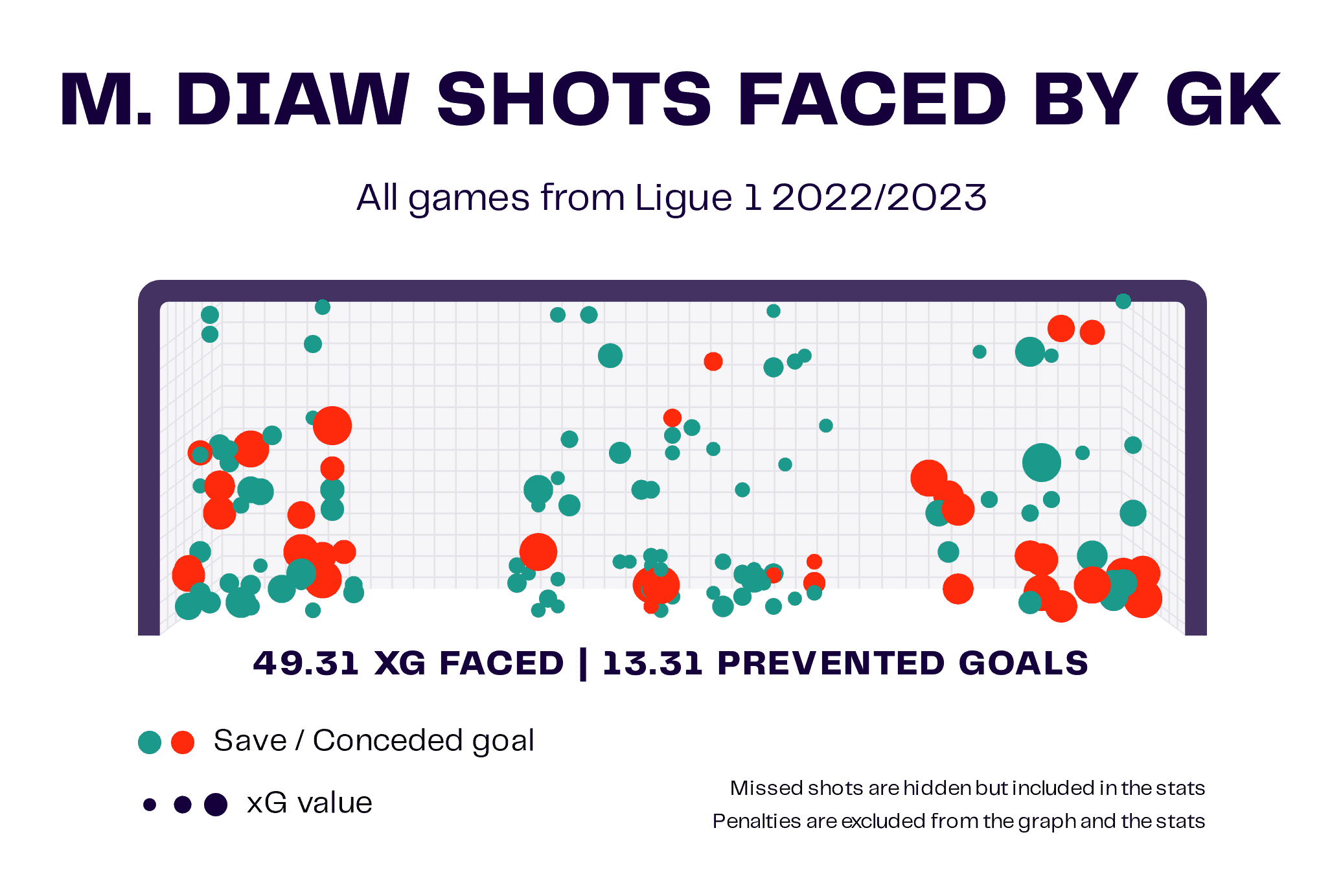
Diaw has faced the sixth-most shots (165) and the sixth-most xG (49.31) of any ‘keeper in France’s top flight this term. He has maintained a solid 72.44% save rate and, with penalties excluded from the stats, has prevented a whopping 13.31 goals with his saves based on the quality of chances conceded.
Diaw has pulled off a highly impressive shot-stopping performance this season. With the obvious advantage of his height, he has showcased good diving and great reach. Furthermore, he typically anticipates shots from distance well, though he struggles with low-driven shots.
However, how much he’ll struggle with those shots will largely depend on how telegraphed they are. If he sees it coming and has time to get down early, he won’t have problems.
The Clermont stopper doesn’t always run out to collect balls played in behind his defence — he doesn’t like to sweep. This can be a disadvantage for his team as if a fast attacker makes their way in behind Clermont’s backline, they can set up an opportunity to take a low-driven shot from close-range, which would be difficult for Diaw to get down to and stop. These are typically the types of shots that Diaw concedes, even if placed centrally, though obviously, the corners would be a better target for the attackers.
In general, Diaw has been a very reliable asset between the sticks for Gastien’s side this season, and they’ve relied on him quite a lot to prevent goals. Of course, there are certain types of shots he struggles with but after arriving as a free transfer last summer, there can be no complaints about the quality Diaw has delivered at Stade Gabriel Montpied.
Defensive approach
Lastly, we’ll take a brief look at some pivotal elements of Les Lanciers’ defensive approach in 2022/23 and how it’s helped them to reduce their goals conceded from 69 last term (joint-third-highest in the league) to 43, at the time of writing, this season (ninth-lowest in the league), along with their xGA per shot from 0.14 — the highest in Ligue 1 last season — to 0.124, which is the third-lowest in Ligue 1 this season. Clermont have, however, conceded more shots this season (11.54) than they did last season (10.24).
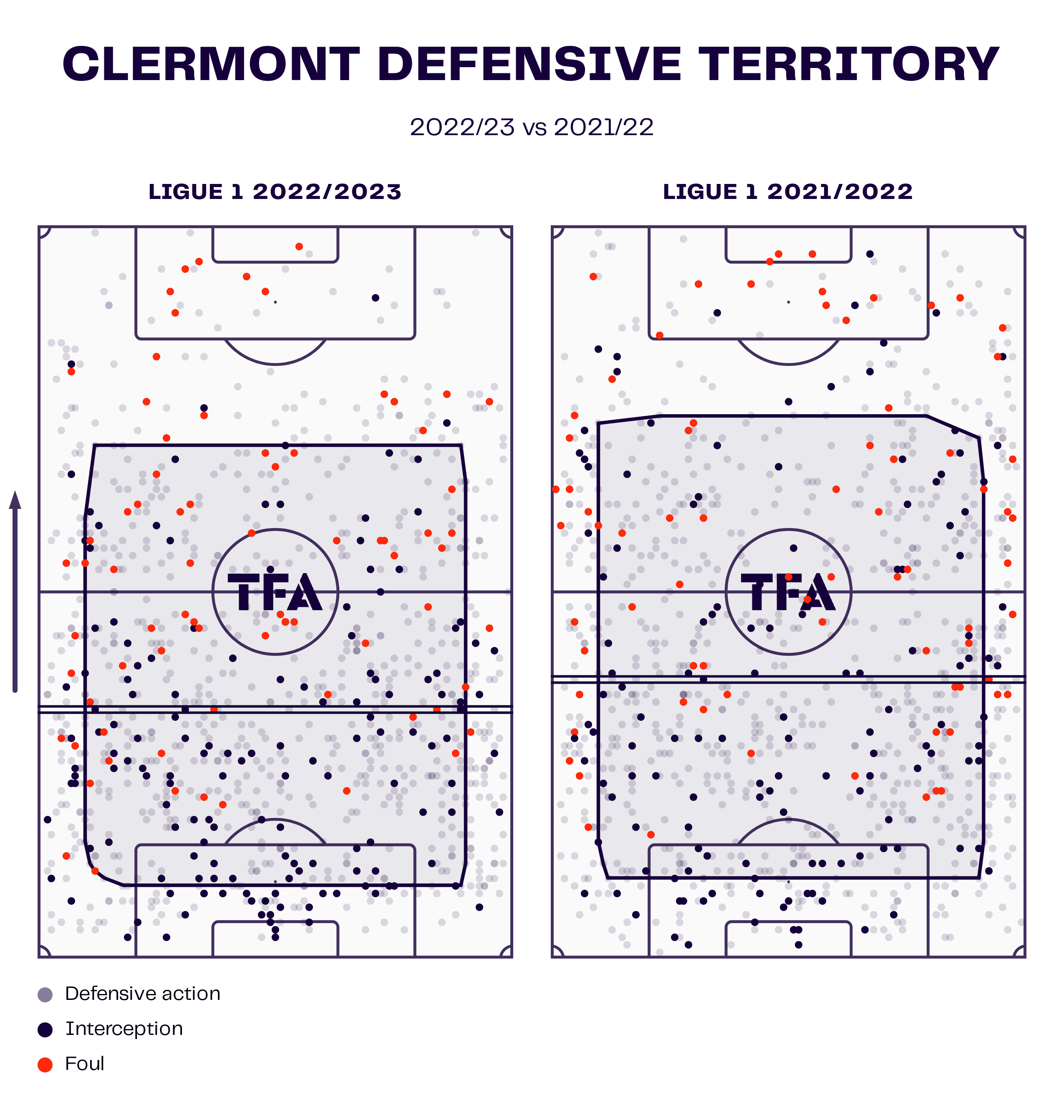
Figure 8 compares Clermont’s defensive territory this season with that of last season. It’s clear that Clermont defended slightly higher last season than they do this season. This is evident from their average defensive line height which has moved a few feet back this term and the amount of defensive actions occurring deep inside their own half, including inside the penalty box, now compared with last term.
However, their PPDA — a key indicator of pressing intensity with a lower number indicating a more intense press — has actually dropped this season (12.94) compared to last season (13.91). Nevertheless, they rank sixth-highest in the league for PPDA in both seasons and have taken a fairly similar defensive approach, despite some small differences in the area of engagement, defensive line height and PPDA.
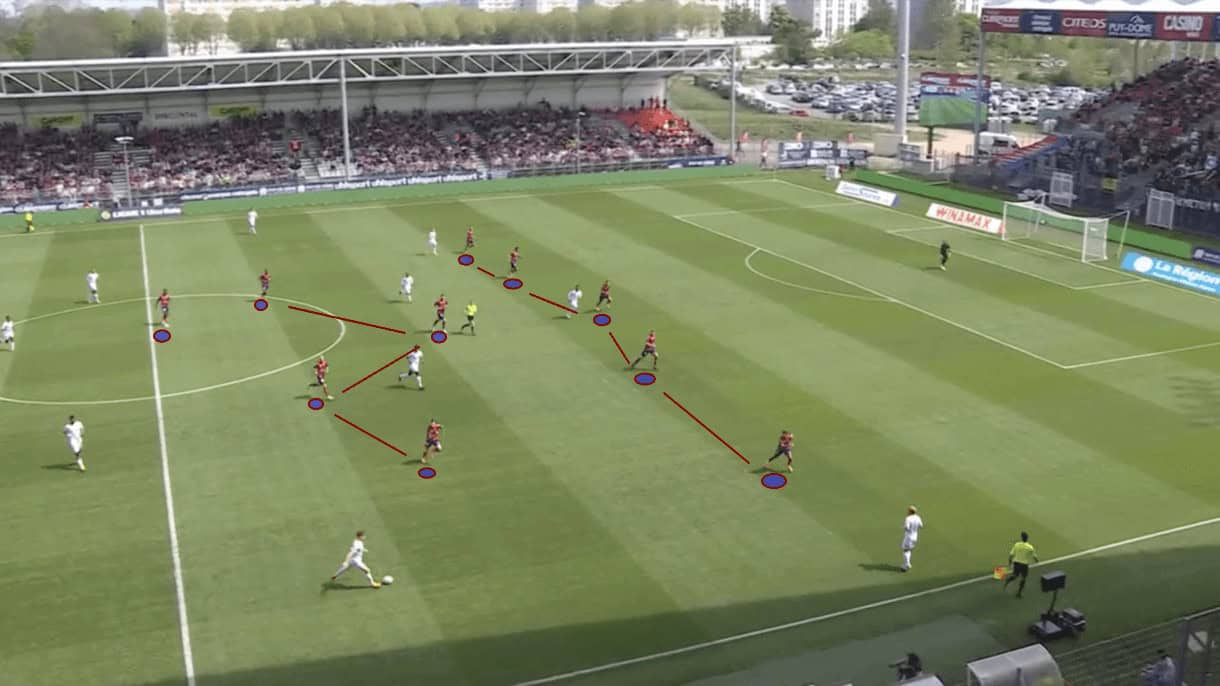
Figure 9 shows a typical example of Clermont’s out-of-possession setup in 2022/23. They typically defend in a mid-block, similar to last season, with their pressing intensity generally increasing once the opposition get just beyond the halfway line.
Their wing-backs drop back to sit alongside the three centre-backs, allowing them full coverage across the pitch in this way with the five-man backline. The wing-backs will, of course, be the most aggressive of the five defenders, due to their wide positioning.
They’ll typically be occupied with the opponents’ most advanced wide players, though, with the Clermont attacking midfielders/wingers dropping to support them alongside the central midfielders, as figure 9 shows.
When the ball is played to a particular wing, the ball-near wide midfielder will press aggressively while the rest of the midfield shifts over slightly but remains focused on controlling the centre. This is true for the ball-far wide midfielder as well, who will focus more on shifting over to help control the centre of the pitch than retaining access to the ball-far opposition winger.
The level of coverage across the pitch and the access the wide men have to the opposition’s wide options — as well as the freedom the wing-backs and wingers have to press aggressively with the safety net of three centre-backs behind them have helped Clermont to reduce the quality of chances the opposition have enjoyed against them this season. Meanwhile, the way their midfield works also helps them to retain control of the centre and prevent overloads from occurring here.
Of course, this can leave them vulnerable to the switch of play but the ball-far wing-back is always there to cover this option and limit the extent to which the opposition can use it to exploit them.
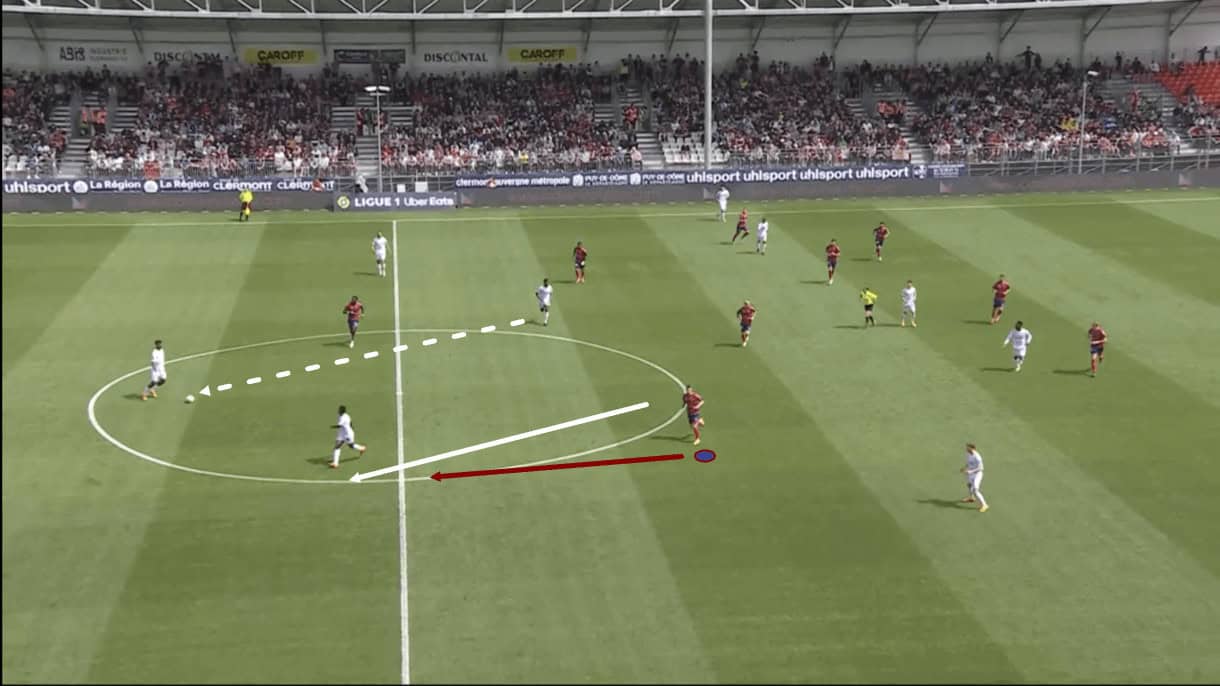
Clermont’s midfielders mark zonally and pick up threats that could receive the ball in and around their zone. As a result, they must react quickly as the picture changes with the opposition passing the ball around and changing their possible passing options. This split-second decision-making can inevitably lead to mistakes and opportunities for the opposition to break through Clermont’s defence, of course, as figures 10-11 show.
In figure 10 above, we see an opposition midfielder dropping as the ball is played across to the centre-back; as this midfielder drops, Clermont’s midfielder is drawn out with him, having previously been marking this player in his zone before.
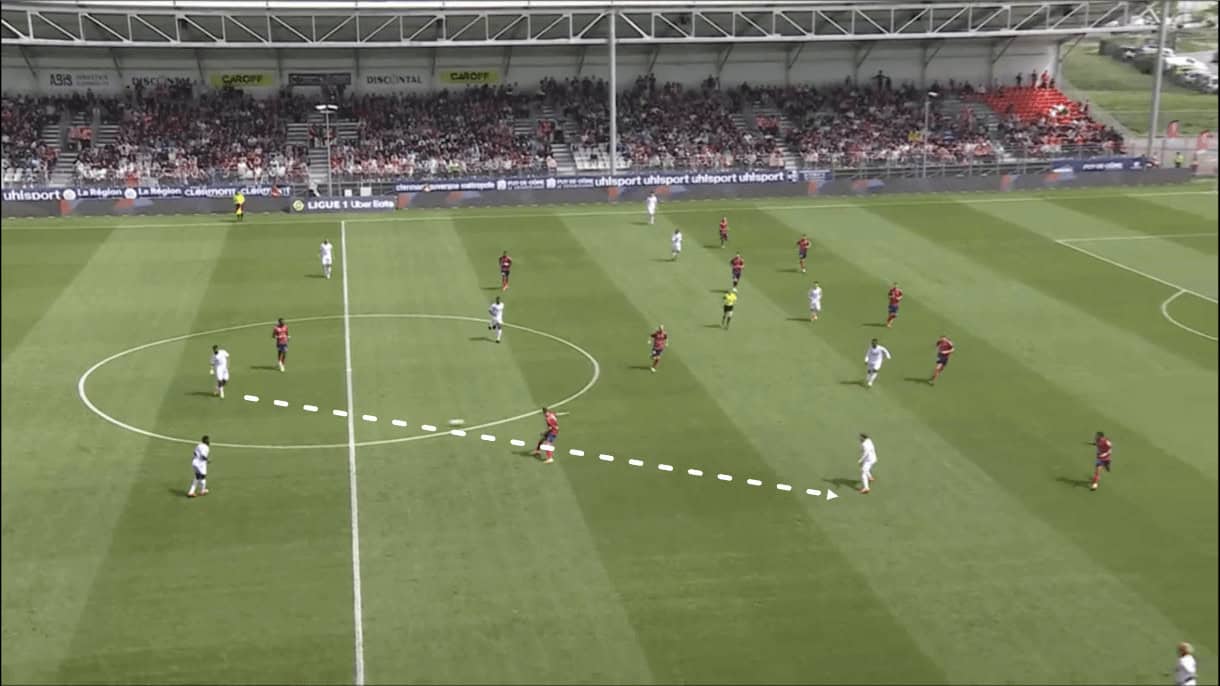
The Clermont midfielder takes his eye off the movement behind him and recognises the danger too late, allowing the opposition to progress in behind this midfielder and set up an opportunity to run at Clermont’s defence.
Organisation and spatial awareness can be key for Clermont’s defensive tactics due to the importance of organisation in their defensive tactics. They can’t allow big gaps like this to open up in their shape or it will leave the defence weak. This kind of error and, as mentioned earlier, instances of the opposition getting in behind Clermont’s backline, be that via a counterattack or a settled attack like this, are the main reasons for chances and, indeed, goals conceded for Clermont this term.
Still, they’ve done well to reduce their goals conceded substantially this season and frustrate opponents much more by denying them the level of chance quality they enjoyed against them last term.
Conclusion
To conclude our tactical analysis and team-focused scout report, we can see that Clermont have evolved effectively from last season, with some really efficient recruitment and tactical tweaks on display from the Auvergne-Rhône-Alpes club. Whether it’s with the signing of new players or the assignment of new roles for some players who were already at the club, they’ve done well to minimise the impact of the exodus of key men from last season
Their defensive improvements have also played a massive part in their improved league standing this season, and that comes down to a combination of their tactical approach and some heroics from Mory Diaw — another example of very intelligent Clermont recruitment.
Still, they can’t afford to get complacent after this season as with their quality, they can’t expect to be safe in the next campaign without a lot of hard work again — the odds will be against them, however, they’ve now shown that they are to be taken very seriously in France’s top flight, as they prepare to embark on their third Ligue 1 campaign in 2023/24.





Comments